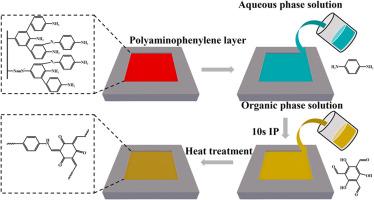Rapid preparation of extremely highly permeable covalent organic polymers nanofiltration membranes for alcohol recovery via interfacial polymerization
IF 9.5
引用次数: 0
Abstract
Covalent organic polymers (COPs) membranes have been widely investigated in recent years for the application and preparation of composite nanofiltration (NF) membranes due to the abundant pore structure. However, there are still difficulties in the easy and reliable preparation of scalable and highly permeable COPs membranes. In this work, the polyaminophenylene (PAP) layer was constructed on polysulfone (PSF) ultrafiltration membranes by diazonium-induced anchoring process (DIAP), and then used as a substrate to prepare ultra-thin and highly permeable COPs NF membranes by interfacial polymerization (IP) in only 20 s. The presence of PAP layer increases the aqueous phase monomer storage to promote the forward progression and limits the reaction zone of IP, thus resulting in ultrathin and highly crosslinked COPs membranes. In addition, the PAP layer covalently grafted onto the PSF molecular chain also participates in the IP reaction, thus the separation layer is connected to the substrate as a whole for better stability and can operate for long periods of time in an alcohol-based organic solvent environment. The methanol permeance of optimal NF-PAP membrane prepared based on the above strategy can reach 362-398 L−1m−2h−1bar−1, which almost achieves an order of magnitude enhancement relative to other reported COPs organic solvent nanofiltration (OSN) membranes. The retention rate of the COPs composite membrane for naphthol green B (Mw = 878) dye was about 98.5 %, demonstrating good alcohol recovery ability. In conclusion, this study offers a potential strategy for the development and application of COPs OSN membranes.

通过界面聚合快速制备用于酒精回收的极高渗透性共价有机聚合物纳滤膜
共价有机聚合物(COPs)膜因其丰富的孔隙结构,近年来在复合纳滤膜(NF)的应用和制备方面受到广泛关注。然而,要简单可靠地制备出可扩展的高渗透性 COPs 膜仍存在困难。在这项工作中,通过重氮诱导锚定工艺(DIAP)在聚砜(PSF)超滤膜上构建了聚氨基苯烯(PAP)层,并以此为基底通过界面聚合(IP)在短短 20 秒内制备了超薄高渗透 COPs NF 膜。PAP 层的存在增加了水相单体的储存量,促进了前向进展,并限制了 IP 的反应区,从而制备出超薄、高交联 COPs 膜。此外,共价接枝到 PSF 分子链上的 PAP 层也参与了 IP 反应,因此分离层与基底整体相连,稳定性更好,可在醇基有机溶剂环境中长期运行。基于上述策略制备的最佳 NF-PAP 膜的甲醇渗透率可达 362-398 L-1m-2h-1bar-1 ,与其他已报道的 COPs 有机溶剂纳滤膜相比,几乎提高了一个数量级。COPs 复合膜对萘酚绿 B(Mw = 878)染料的截留率约为 98.5%,显示了良好的酒精回收能力。总之,这项研究为 COPs OSN 膜的开发和应用提供了一种潜在的策略。
本文章由计算机程序翻译,如有差异,请以英文原文为准。
求助全文
约1分钟内获得全文
求助全文
文献相关原料
公司名称
产品信息
阿拉丁
Congo red (CR)
阿拉丁
Methyl blue (MB)
阿拉丁
Methyl orange (MO)

 求助内容:
求助内容: 应助结果提醒方式:
应助结果提醒方式:


